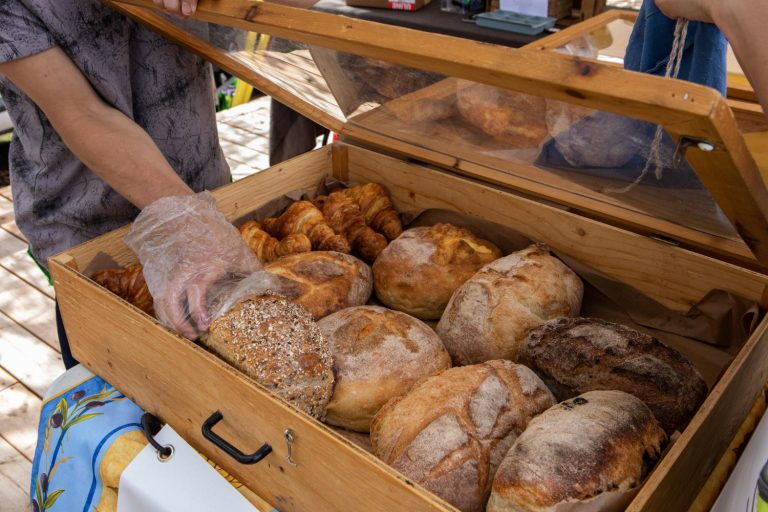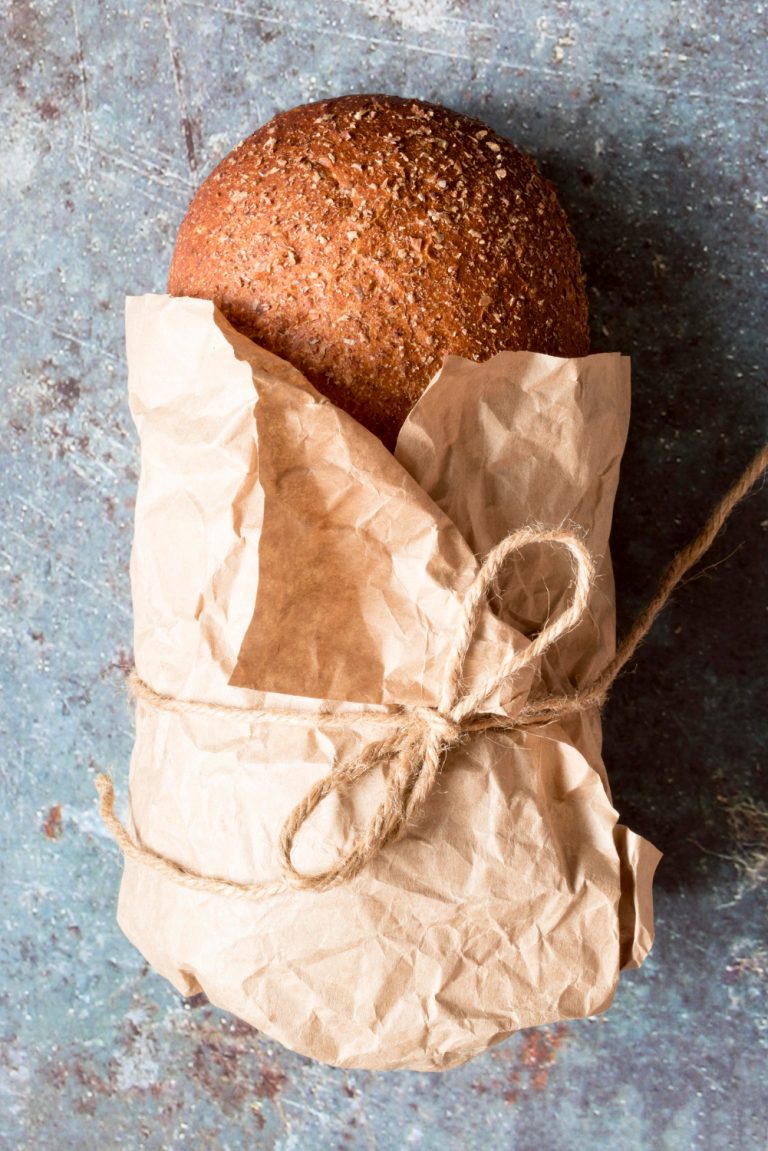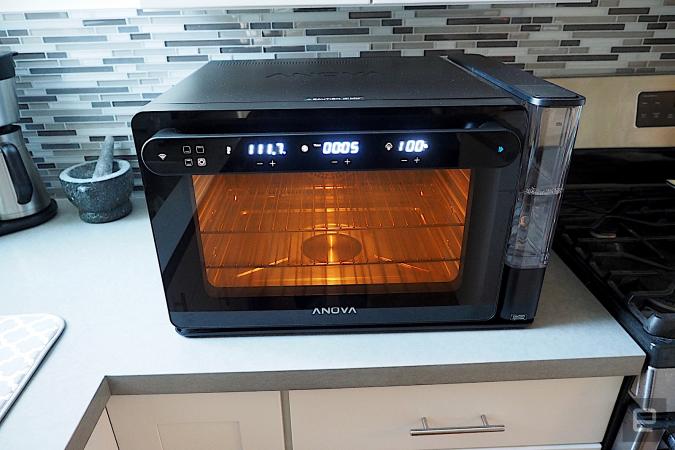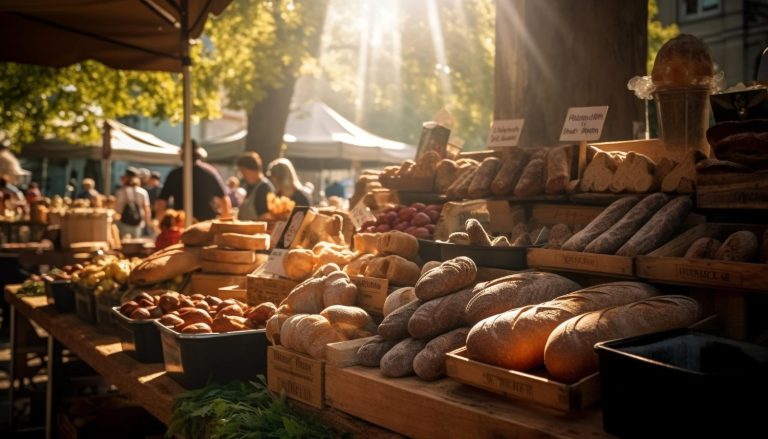How to Master the Crispy Sourdough Crust Technique: A Step-by-Step Guide
A crispy sourdough crust is one of the toughest challenges artisan bread bakers face. Home bakers often can’t balance a crackling exterior and a soft, open-crumb interior. Mastering the crispy sourdough crust technique, which blends precise temperature control, proper steam management, and careful dough preparation, produces professional-quality results.
This detailed guide teaches you everything you need to know to create an exceptional sourdough bread crust. You’ll discover the secrets of starter maintenance, dough development, proper scoring techniques, and steam injection methods. The guide also helps you fix problems like overly thick crusts and dense interiors with practical tips that lead to consistent, bakery-worthy results.
Understanding the Science of Crispy Crusts
The science behind a crispy sourdough crust lies in the chemical processes during baking. Steam, temperature, and gluten development create that distinctive crackling exterior bakers love.
The Role of Steam
Steam plays a significant role during the first 15 minutes of baking and creates optimal conditions for crust development. At the time moisture exists in the oven, it helps several essential processes:
- Maintains surface elasticity for maximum oven spring
- Helps starch gelatinization at 82°C (180°F)
- Creates the signature glossy appearance
- Delays crust formation for better expansion
Steam presence keeps the dough’s surface flexible while the bread expands. This prevents premature crust hardening and allows maximum volume development.
The Importance of Temperature
Temperature control shapes fermentation and crust development throughout different phases:
| Temperature Range | Effect on Crust |
|---|---|
| 135°C (275°F) | Sugar caramelization begins |
| 150-205°C (302-401°F) | Maillard reaction occurs |
| 220-230°C (428-446°F) | Optimal baking temperature |
Proper temperature management determines your bread’s crust characteristics. The crust becomes crustier at higher temperatures and softer at lower temperatures. The suitable temperature range helps moisture evaporate, triggering chemical reactions that develop color and flavor.
Gluten Development
The protein network from gluten development directly affects crust quality. Strong gluten formation creates a vital structure that helps proper oven spring and crust development. Properly developed gluten:
- Builds a network that traps gas bubbles well
- Gives structure to form an optimal crust
- Helps bread keep its shape while baking
- Adds to the final texture of crust and crumb
Weak gluten development often results in dense loaves with thick, chewy crusts. The gluten network should be strong enough to handle expanding gasses and maintain the bread’s structure during baking. Bakers achieve this balance through proper kneading and enough fermentation time.
Steam, temperature, and gluten work together to create perfect crust formation. The dough’s surface loses moisture, creating a thin, crispy layer that improves through the Maillard reaction and caramelization. Bakers use this scientific knowledge to control and adjust their techniques for consistent, professional results.
Essential Tools and Ingredients
The perfect sourdough crust comes from a blend of proper technique and the right tools. Quality ingredients and adequate equipment distinguish good and great sourdough bread.
High-Protein Flour
Professional bakers use high-protein flour as the foundation of exceptional sourdough bread. The ideal protein content ranges from 12.7% to 14%, providing the structure for proper gluten development. This type of flour brings several advantages:
- Stronger and more stable dough
- Greater oven spring and volume
- Better handling of long fermentation
- Excellent crust development
Professional bakers should increase hydration levels with high-protein flour because the additional protein needs more water to form optimal gluten. This adjustment prevents dense or tough results and helps create the desired crispy crust.
Dutch Oven or Baking Stone
Choosing a Dutch oven and a baking stone significantly affects the crust’s development. These tools create an optimal baking environment in different ways:
| Baking Tool | Benefits |
|---|---|
| Dutch Oven | Steam retention, even heat distribution, consistent results |
| Baking Stone | Multiple loaf capacity, excellent heat retention, professional-style crust |
A Dutch oven traps steam effectively during the vital first phase of baking and promotes better crust development. You should maintain a temperature of 230°C (450°F) with the lid on for 30 minutes, then reduce it to 210°C (410°F) and remove the lid for 10-15 minutes.
A baking stone crafted from cordierite delivers steady heat transfer with excellent temperature stability. The stone absorbs and radiates heat evenly, creating a perfect foundation for a crispy crust. The stone needs at least 45 minutes of preheating time to achieve the best results.
Razor Blade or Lame
Scoring plays a significant role in controlled oven springs and attractive crust development. Bakers use a bread lame (pronounced “Lahm”) or razor blade to create precise cuts that guide the bread’s expansion during baking. Your scoring tool needs these characteristics:
- Sharp, well-exposed blade
- Lightweight, comfortable handle
- Easy blade replacement system
- Minimal blade housing for clean cuts
Professional bakers typically replace their blades after 5-10 loaves to maintain optimal sharpness. The blade works effectively from all four corners and maximizes its lifespan while delivering clean cuts. The blade should rest at a 20-30-degree angle to achieve optimal results during scoring.
A digital scale with ±2 grams of accuracy supports these essential tools and ensures precise measurements for consistent results. Temperature monitoring tools help bakers maintain ideal conditions throughout fermentation and baking, leading to superior crust development.
Preparing Your Sourdough Starter
A properly cared for healthy sourdough starter helps you create bread with that perfect crispy crust. Your starter’s good condition sets up the right environment for fermentation and optimal dough development that directly affects the final crust quality.
Feeding Schedule
Your sourdough starter’s feeding schedule depends on room temperature and how often you bake. Bakers need a consistent feeding routine that matches their baking habits:
| Feeding Frequency | Storage Method | Best For |
|---|---|---|
| Once daily | Room temperature | Regular bakers (2-3 times/week) |
| Twice daily | Room temperature | Daily bakers |
| Weekly | Refrigerated | Occasional bakers |
A 1:1:1 ratio (starter:flour: water) is the standard feeding proportion. This mixture ferments quickly and becomes ready in 4-6 hours. Bakers who prefer slower fermentation should use a 1:4:4 ratio that peaks in 10-12 hours. The water’s temperature must stay lukewarm because boiling water can damage beneficial bacteria.
Testing for Readiness
A ripe starter shows distinct signs that tell you it’s ready to use in baking. You need to watch out for these signs before you mix the starter into your dough:
- Visual Signs:
- Doubles or triples in volume within 4-6 hours
- Bubbles visible on the surface and sides
- Domed shape at peak activity
- Honeycomb structure when viewed from the jar side
When ready, the starter should feel like a thick pancake batter or warm peanut butter. It needs to be light and airy, with a stretchy texture that holds its shape but still pours easily. You’ll notice a pleasant tangy smell without any harsh vinegar-like or off-putting odors.
The best results come after waiting 14 days from the original starter creation before starting to bake. Some recipes might suggest less time, but a fully mature starter will give better fermentation and superior crust development. The starter needs consistent feeding during this time to build a stable colony of good bacteria and wild yeasts.
Temperature is a vital factor in your starter’s activity. Your starter works best between 70-75°F (21-24°C). Warmer spots require more frequent feeding, while cooler areas require longer fermentation times. You should adjust your feeding schedule based on these conditions while keeping your chosen ratio the same.
Your starter becomes dormant in the refrigerator and needs fewer feedings. However, a refrigerated starter must wake up with at least one room-temperature feeding cycle before baking. This step ensures the yeast colonies are active enough to create proper fermentation and give your bread the desired crust.
Mastering the Dough-Making Process
Learning to make a crispy sourdough crust technique requires understanding three significant processes that turn simple ingredients into artisanal bread. These steps build upon each other and are the foundations for exceptional crust development.
Autolyze Technique
Gluten development begins when flour and water combine in the autolyze process. This significant first step hydrates the flour thoroughly, enabling enzymes to break down complex proteins—a shaggy mass forms when bakers mix flour and water at room temperature. The mixture needs to rest for 30 minutes to 2 hours. The dough reshapes the scene from a rough mixture into a smooth, extensible mass during this time.
The dough’s proteins develop naturally when bakers add the starter and salt after the autolyze. This approach reduces mixing time and enhances the dough’s structure. The technique works mainly when the perfect balance between extensibility and strength is needed for proper crust formation.
Stretch and Fold Method
The stretch and fold technique builds dough strength without aggressive kneading after autolyzing. This gentle manipulation method develops gluten structure and preserves delicate gas bubbles that help proper fermentation. The dough needs specific timing patterns:
| Fold Set | Timing | Dough Indicators |
|---|---|---|
| First | 30 min after mixing | Loose, elastic |
| Second | 15-30 min after first | Increasing resistance |
| Third | 30 min after second | Notable strength |
| Fourth | 30-60 min after the third | Smooth, cohesive |
Each set needs four-folds, and you should rotate the dough 90 degrees between movements. You should handle the dough with wet hands to prevent sticking and use gentle but thought-out movements to keep the gas inside.
Bulk Fermentation
Bulk fermentation is vital in developing the dough’s flavor and structure. This phase starts right after the final stretch and fold. It takes 4-5 hours at 70-75°F (21-24°C). The dough changes a lot during this time and shows several signs of proper development:
- Visual and tactile indicators:
- The volume doubles (50-100% increase)
- The surface becomes smooth with a dome-shape
- Bubbles appear on top
- The dough jiggles when you move the bowl
- The edges pull away clearly from the container
Temperature control shapes how the crust develops. Higher temperatures speed up fermentation but might weaken the structure. Lower temperatures take longer but often create better flavors. Bakers should watch the dough’s visual signs instead of just the clock. Room conditions can greatly affect fermentation speeds.
The dough naturally becomes stronger during bulk fermentation. Enzymes and good bacteria work together to build strength. This natural process adds to the earlier hand-working of the dough. These elements create the perfect base for an outstanding crust. The magic happens when these three processes blend together perfectly to make dough with the best structure and fermentation qualities.
Shaping and Proofing for Optimal Results
Proper shaping and proofing techniques transform well-developed dough into bread with exceptional crust characteristics. These final steps before baking are significant in achieving the desired texture and appearance in the finished loaf.
Creating Surface Tension
When you develop surface tension during shaping, a solid outer layer forms, dramatically affecting the final crust quality. The tension helps your loaf maintain shape, leading to optimal oven springs during baking. You should focus on creating a tight, smooth exterior without tearing the dough’s surface.
Surface tension works best when you consider these important factors:
- Strong dough from previous development
- Smooth, well-coordinated shaping movements
- Enough bench rest between pre-shape and final shape
- Right amount of flour during shaping
Rice flour works best during shaping because it prevents sticking and protects the dough’s surface integrity. Your shaping motion must be firm but gentle to create tension without damaging the carefully developed gluten structure.
Cold Fermentation
Cold fermentation, or retarding, improves flavor development and crust characteristics. The process takes place in a refrigerated environment that needs specific settings to get the best results:
| Duration | Temperature | Expected Outcome |
|---|---|---|
| 5-24 hours | 38-42°F (3-6°C) | Enhanced flavor |
| 24-48 hours | 38-42°F (3-6°C) | Maximum complexity |
Your choice to cover or leave dough uncovered during cold fermentation depends on your fridge type:
For fridges with circulation systems:
- Cover the dough with plastic to stop it from drying out
- Put the basket inside a plastic bag
- Fold bag opening under basket
- This creates a protective microclimate
For standard fridges:
- You can leave dough uncovered
- It will keep its natural moisture balance
- The surface can dry slightly to make scoring easier
Cold fermentation creates a thin skin on the dough’s exterior, making handling and scoring much easier. Since the dough stays safe without over-fermenting, you can also better plan your baking schedule.
The temperature gap between dough and fridge creates some challenges you must watch. You should do one or two gentle folds in the first hour of cold fermentation to:
- Even out the dough’s temperature
- Keep fermentation rate steady
- Keep the best structure
- Get better crust development
Wetter doughs need extra folds every 30 minutes to maintain their structure while cooling. Good temperature control will ensure consistent fermentation throughout the dough and improve crust development in the final bake.
Good surface tension and controlled cold fermentation create perfect conditions for a fantastic crust. These techniques will give you bread with a thin, crispy exterior that breaks like fine French pastry instead of turning tough and leathery.
Baking Techniques for the Perfect Crust
The final stages of sourdough bread baking demand careful control of steam, temperature, and cooling. These crucial elements combine to produce that distinctive crackling crust of exceptional artisan bread.
Steam Injection Methods
Bakers across various skill levels use steam injection techniques during the significant first phase of baking. Steam in the oven chamber plays multiple roles:
| Steam Phase | Duration | Purpose |
|---|---|---|
| Pre-steam | 5 minutes before loading | Prepare oven environment |
| Initial steam | First 15-20 minutes | Maximum oven spring |
| Steam removal | After 20 minutes | Crust development |
Home bakers can achieve professional-level steam conditions through these proven methods:
- Dutch Oven Method: Trap natural dough moisture
- Ice Cube Technique: Place 2-3 ice cubes under parchment
- Water Pan System: Pre-heated pan with boiling water
- Spray Bottle Approach: Multiple bursts during the first 10 minutes
Temperature Control
A crispy sourdough crust technique depends on precise temperature management during the baking process. The oven should be pre-heated at 500°F (260°C) for 45-60 minutes before the bread goes in. This will give a consistent heat distribution and help develop the crust immediately.
The bread’s perfect crust needs specific temperature adjustments:
Original Baking Phase (0-20 minutes):
- Keep the temperature at 500°F with steam
- The oven door must stay closed
- The dough will achieve maximum oven spring
Crust Development Phase (20-35 minutes):
- Lower the temperature to 450°F (232°C)
- Take out the steam source
- Watch the crust’s color development
Final Baking Phase (35-45 minutes):
- Keep the temperature steady at 450°F
- Measure the bread’s internal temperature
- Look for a core temperature of 205°F (96°C)
Cooling Process
You need a perfect cooling phase to achieve that amazing sourdough crust. The bread’s internal structure sets during cooling while maintaining the crust’s best qualities. Several factors play a vital role in this process.
The original cooling period needs the right environment. Place your loaf on a wire rack away from drafts at 68-72°F (20-22°C). These temperatures will properly balance moisture and help develop that perfect crust.
Here’s what you need to do for the best results:
First 10 minutes:
- Keep the bread in your turned-off oven
- Leave the door slightly open
- This lets the temperature drop slowly
Next 45 minutes:
- Move it to a wire rack
- Make sure air flows freely around it
- Don’t cover the bread yet
Final cooling (2-3 hours):
- Let it cool completely at room temperature
- Check if the bottom crust feels right
- You might hear some crackling
Steam, temperature, and cooling are the foundations of exceptional crust development. Professional bakers carefully monitor these elements and adjust their methods based on room conditions and goals. This takes patience and attention to detail, but becoming skilled at these techniques will give you consistent, professional-quality results.
Your temperature readings matter throughout the baking process. A good oven thermometer and instant-read probe will help you take precise measurements. These tools help create the right conditions for a great crust and ensure every loaf turns out just as good as the last.
The crust’s final quality depends on when you let the steam out. You’ll get a thick, tough crust if you release it too soon. Wait too long, and your bread won’t brown or crisp properly. Watch for signs like the first hint of crust forming and how the color develops to know when to release the steam.
Conclusion
The crispy sourdough crust needs careful attention to multiple technical elements that work together. Steam management, temperature control, and proper fermentation are the foundations for exceptional results. Precise shaping techniques and proofing methods build on this base. You need patience and practice for each step. Understanding these fundamental principles enables bakers to achieve professional-quality crusts with the perfect balance of crackle and chew consistently.
Scientific knowledge and proper technique turn simple ingredients into remarkable bread. Bakers who become skilled at these methods create loaves worthy of artisanal bakeries with thin, shattering crusts and perfectly developed crumb structures. Lift your bread and pizza game with an authentic artisanal sourdough starter from The Yeast We Can Do. Our small-batch starter will help you create exceptional bread and pizza with that perfect tangy flavor and signature crust, whether you’re a passionate home baker or a restaurant owner who wants to add true sourdough’s unmistakable flavor and character to your menu. Email john@theyeastwecando.com to get your hands on our premium sourdough starter and change your baking today.
FAQs
What is the key to achieving a crispy crust on bread?
The secret to a crispy crust is preheated pizza stone or baking steel. When placed in the oven, these tools become extremely hot and transfer intense heat to the bread dough, promoting the bottom crust’s rapid rise and browning.
How can I make my bread crust crunchy?
Retaining steam around the bread as it bakes is crucial to achieving a crunchy crust. This can be accomplished by covering the bread with a lid, spraying the dough with water before baking, or placing a shallow pan of water in the oven during baking.
What contributes to the crispiness of a crust?
A baking stone or pizza stone enhances crust crispiness. Before baking, these stones should be heated in the oven at high temperatures (450°F to 500°F). The stone retains heat, giving the bread’s bottom crust excellent browning and crispiness.
What should I apply to bread dough to get a crispier crust?
Brush or spritz water onto the bread dough before baking for a crispier crust. Water prevents the dough’s outer skin from forming too quickly, allowing the bread to expand more during baking and smoothing the crust for a finer appearance.






